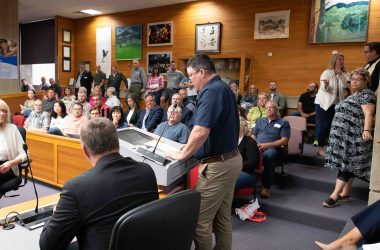From the lab of the Salem’s City Archaeologist: Burnett’s Cocoaine Bottle- Bottle – green/blue tinged; “Burnett’s Cocoaine,” “Boston,” 7″ tall x 2-1/2″ wide x 1-1/2″ deep, top diameter 1-1/4″
This bottle was found earlier this summer in downtown Salem during the repair of a portion of sidewalk and recovered, along with a number of other bottles and ceramic shards, after obtaining the required Archaeological Permit from the Oregon State Historic Preservation Office. The exciting thing about this bottle is that it is intact (many are often broken) and the name of the product, “Burnett’s Cocoaine” is clearly visible, along with the location the bottle was manufactured: “Boston.”
My first task was to see if I could track down a biography of Joseph Burnett, the founder of Burnett & Co., who manufactured Burnett’s Cocoaine. I found an excellent summary of his life and accomplishments created by the Southborough Historical Society.
Joseph Burnett was born on Nov. 11, 1820 in Southborough, Massachusetts. From 1835-1837 he attended Worcester Technical College and the Worcester College of Pharmacy, graduating with a Doctorate in Chemistry. In 1837 he began working for Theodore Metcalf, an apothecary in Boston, and by 1845 he had become a full partner. The company became known as the Burnett & Metcalf Chemical Co. and manufactured and sold drugs. In 1846 their company manufactured the first anesthetic (diethyl ether) that was used by Dr. W.T.G. Morton to perform the first painless surgical operation in the United States at Massachusetts General Hospital.
In 1847 Burnett created the first liquid vanilla extract commercially produced and sold in the United States. The Fitchburg Sentinel in Massachusetts published an article on Nov. 1, 1881 featuring an interesting story about how Burnett first expanded into the extract business. The article describes an incident occurring in 1846 at Burnett and Metcalf’s apothecary shop on Tremont Street in Boston: “
A lady who had lived in France and became accustomed to French methods of cookery came into Mr. Burnett’s store one day and asked him if he could not make a decent Flavoring Extract for her as she found those in common use abominable. She wanted an extract of vanilla. This was made, which please the lady very much and from this simple beginning has grown a business, one single branch of which now consumes one fourth of the entire Mexican product, which is the only recognized best quality of Vanilla in the world.
Burnett sold his share of the partnership with Metcalf in 1855 and formed his own company, the Joseph Burnett Company of Boston. He first created Cocoaine for the Hair in 1857, which was named for the product’s primary ingredient, coconut oil. He established his business at 27 Central Street in Boston.
My next task was to gather more information about this product, and how Salem residents may have used it. I was able to find advertisements for this product in the Oregon Statesman. The People’s Drug Store (proprietors P.D. Palmer and Henry S. Stipp) sold this product in Salem, advertised in the Weekly Oregon Statesman throughout 1858 and 1859. Henry Stipp was also a journalist for the Oregon Statesman for a time.

I also searched newspapers and periodicals across the country to get a larger sense of how Burnett & Co. advertised their product. Many newspapers included testimonials from people who used this product successfully, and one of the periodicals that Burnett most commonly advertised in was the “New England Farmer.”
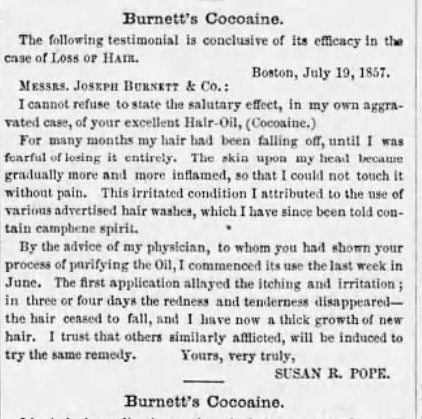
Burnett & Co. began producing an annual Floral Handbook and Ladies Calendar in 1865 through the 1870s. In addition to a calendar, it included an overview of the language of flowers along with full page advertisements of Burnett’s products, including several pages dedicated to Burnett’s Cocoaine hair tonic.
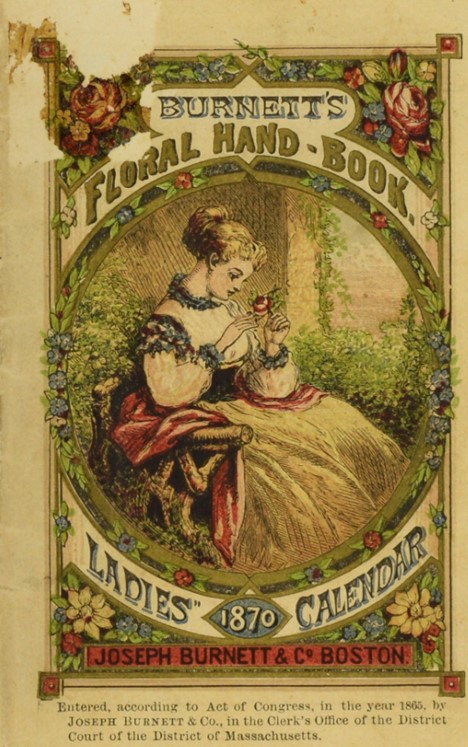
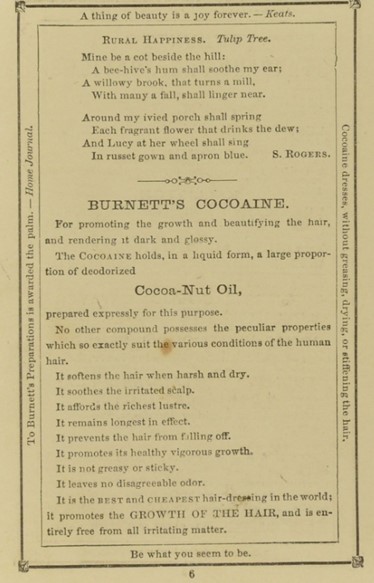
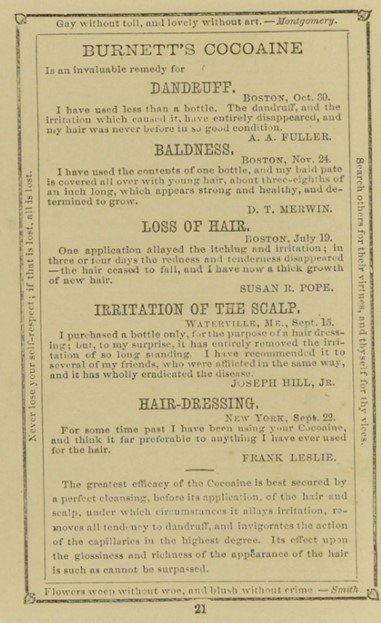
By 1870 Burnett & Co. had expanded their product lines to feature perfume and cologne, toothwash, flavoring extracts as well as other remedies. The company advertised these as “Burnett’s Standard Preparations”.
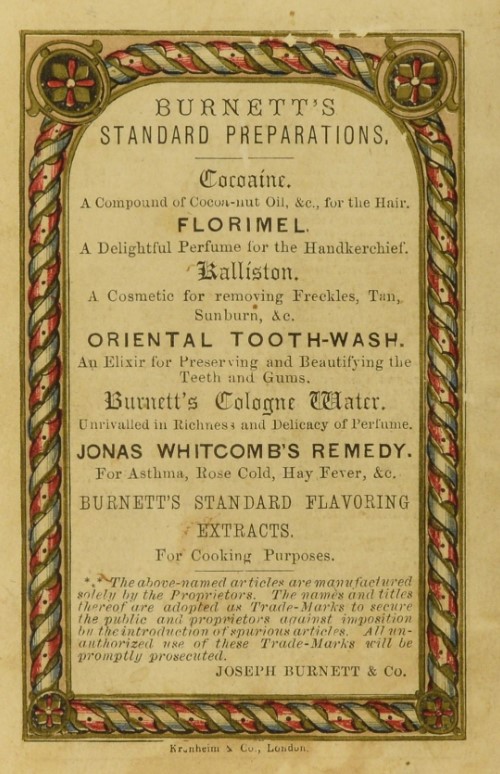
In 1870, Burnett established Deerfoot Farms Company in Southborough where he raised cattle and produced Deerfoot sausage and bottled milk until 1894.
Joseph’s son, Edward, was elected as a U.S. representative and served from 1887-1889. Grover Cleveland visited Deerfoot in 1892 and even made it his Presidential campaign headquarters. Joseph Burnett died on Aug. 11, 1894, in a carriage accident.
The Aug. 14, 1894, Boston Evening Transcript reported that the Boston Druggist Association and the Massachusetts’s College of Pharmacy would both send delegations to his funeral and adopted the following resolution: “Resolved, that his ever constant help and advice have been a great factor in the development and growth of the College of Pharmacy and that his memory will be permanently associated with his success.”
The Joseph Burnett house constructed in 1849-50 is still standing in Southborough, Massachusetts. The Community Preservation Coalition and the Friends of the Burnett-Garfield House have been working since 2014 to ensure the house is preserved.
Now that I have a better understanding of this product, how Salem residents may have used it and the company that manufactured it, the last question that I would like to answer is the date of this bottle.
In 1902, the product changed the spelling to Cocaine, most likely to emulate the success of other products like Coca-Cola. We can narrow down the production date slightly to somewhere between 1857 and 1901. The Society for Historical Archaeology has a wonderful reference guide for historic glass bottle identification that includes a helpful series of questions to help with dating historic bottles.
The body of this bottle was made with a mold (it has faded vertical mold seams on the sides); however, the seam does not extend onto the top surface of the bottle neck rim, meaning that the bottle was most likely mouth-blown with a tooled finish. A majority of U.S. manufactured bottles made between 1820 and 1915 were mouth-blown molded bottles. There is no pontil scar or mark on the base of the bottle, which means the bottle was most likely manufactured after the Civil War (1865). The bottle has a tooled finish as well as a mold base which narrows our date down to sometime between 1855 and the early to mid-1870s, which I think is about as close as we will get to dating our bottle.
Salem’s City Archaeologist is responsible for curating artifacts recovered on City of Salem public property (or in the Right of Way) at the City of Salem’s archaeological lab. I research each artifact’s history and use by Salem’s residents. This information is included in a final report which will be sent to the Oregon State Historic Preservation Office to be added to the Oregon Archaeological Records Remote Access and Archaeology Bibliographic Database, which is a GIS-based web portal that can be accessed by qualified archaeologists and has information on documented archaeological resources and archaeological survey reports.
State law prohibits sharing locational information about known archaeological sites, so no specific geographic location information can be shared with the public. Curation, treatment and education about any recovered Indigenous artifacts on City of Salem public property is restricted and handled in consultation with the tribes. If you come across a historic or indigenous artifact, please leave it in place and contact the City Archaeologist at [email protected] or 971 718-7221.
STORY TIP OR IDEA? Send an email to Salem Reporter’s news team: [email protected].
SUPPORT OUR WORK – We depend on subscribers for resources to report on Salem with care and depth, fairness and accuracy. Subscribe today to get our daily newsletters and more. Click I want to subscribe!
Kimberli Fitzgerald is the city of Salem's archeologist and historic preservation officer. She is a regular contributor to Salem Reporter's local history column.




